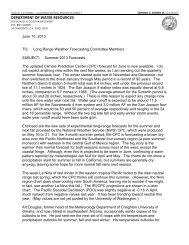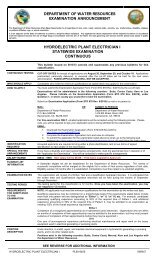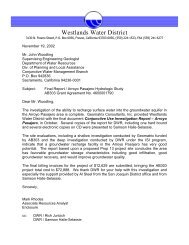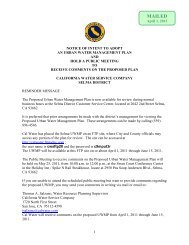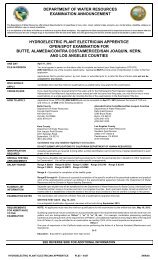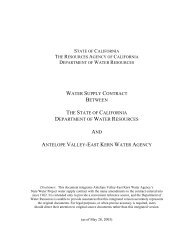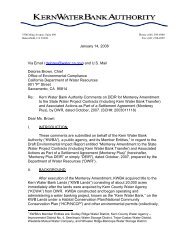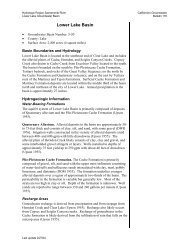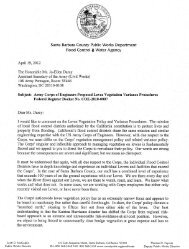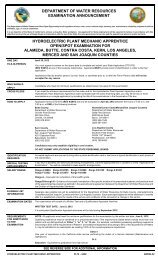Bulletin 1.pdf - California Department of Water Resources - State of ...
Bulletin 1.pdf - California Department of Water Resources - State of ...
Bulletin 1.pdf - California Department of Water Resources - State of ...
Create successful ePaper yourself
Turn your PDF publications into a flip-book with our unique Google optimized e-Paper software.
346 WATER RESOURCES OF CALIFORNIA<br />
RUNOFF<br />
Estimated mean seasonal natural run<strong>of</strong>f <strong>of</strong> the Central Valley Area<br />
for the 53 years from 1894-95 to 1946-47 is 33,636,000 acre-feet, or 47.5<br />
percent <strong>of</strong> total surface run<strong>of</strong>f from mountain and foothill lands in the<br />
<strong>State</strong>. The minimum seasonal flow <strong>of</strong> 9,280,000 acre-feet occurred in<br />
1923-24, and the maximum, totalling 63,300,000 acre-feet, in 1906-07. The<br />
10-year period from 1923-24 to 1932-33 was the driest <strong>of</strong> record in this<br />
Area. Run<strong>of</strong>f during each <strong>of</strong> those 10 years, except 1926-27, was less than<br />
the 53-year mean, and the average was only 66.3 percent <strong>of</strong> this long-time<br />
mean.<br />
Run<strong>of</strong>f from drainage basins <strong>of</strong> the Central Valley Area is derived<br />
largely from snow. Consequently, the major portion <strong>of</strong> seasonal run<strong>of</strong>f<br />
comes during late spring and early summer months from March to June,<br />
inclusive. For Sacramento River the run<strong>of</strong>f during these months is 42.8<br />
percent <strong>of</strong> the seasonal total, for American River, 65.4 percent, and for<br />
Kings River, 71.8 percent. Minimum run<strong>of</strong>f comes from August to<br />
October, inclusive, flow for this period being 9.7 percent <strong>of</strong> total seasonal<br />
run<strong>of</strong>f for Sacramento River, 2.1 percent for the American, and 5.5 percent<br />
for the Kings. Sacramento River drains a region <strong>of</strong> porous lava<br />
formation, with large underground storage capacity. Summer flow <strong>of</strong><br />
the Sacramento is therefore better sustained than is that <strong>of</strong> other streams<br />
in the Area.<br />
An indication <strong>of</strong> variation in monthly flow <strong>of</strong> Central Valley Area<br />
streams, and <strong>of</strong> the percentage <strong>of</strong> seasonal run<strong>of</strong>f that comes during .<br />
each month, is given by data for Sacramento River at Red Bluff, American<br />
River at Fair Oaks and Kings River at Piedra listed in Table 59.<br />
The first records <strong>of</strong> stream flow in the Central Valley Area were<br />
obtained by Wm. Ham. Hall, <strong>State</strong> Engineer from 1878 to 1884. The<br />
only stream gaging station then maintained in the Sacramento River<br />
Basin was at Collinsville, at the mouth <strong>of</strong> the Sacramento. In the San<br />
Joaquin River Basin 20 gaging stations were maintained, most <strong>of</strong> them<br />
at the base <strong>of</strong> the foothills. All stations established by <strong>State</strong> Engineer<br />
Hall were discontinued after 1884, when the <strong>of</strong>fice <strong>of</strong> <strong>State</strong> Engineer<br />
was abolished. As <strong>of</strong> September 30, 1947, records from 96 stations were<br />
published by the United <strong>State</strong>s Geological Survey in the Sacramento<br />
River Basin and 105 in the San Joaquin River Basin.<br />
The first gaging station established in the Sacramento River Basin<br />
by the Geological Survey wa,




